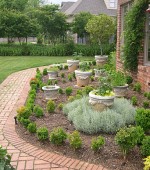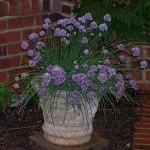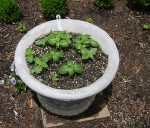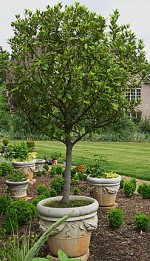 When you are cooking do you want to truck across your back yard for herbs? I don’t so I was determined to have the herbs near the kitchen door. One problem; the patio lies outside the whole back of the house including the kitchen so the herb garden design problem took on a new dimension. Our solution lay in planting herbs in identical 14” decorative pots set on simple plinths in boxwood edged parterres. The number of pots I could incorporate into the parterres was limited so I had to carefully select the herbs that I thought I would use most and would also look attractive all summer. Here are my selections with suggestions for growing:
When you are cooking do you want to truck across your back yard for herbs? I don’t so I was determined to have the herbs near the kitchen door. One problem; the patio lies outside the whole back of the house including the kitchen so the herb garden design problem took on a new dimension. Our solution lay in planting herbs in identical 14” decorative pots set on simple plinths in boxwood edged parterres. The number of pots I could incorporate into the parterres was limited so I had to carefully select the herbs that I thought I would use most and would also look attractive all summer. Here are my selections with suggestions for growing:
Parsley: I grow both the Italian and curly kinds because I am the kind of person that eats the garnish especially if it is parsley. Start seeds 6-8 weeks before you want to plant them out but because they take a long time to germinate, soak them in water for 24 hours before planting. Once they have true leaves and danger of heavy frost is past, plant them outside. A parsley plant or two will do fine on a sunny windowsill in a 4” pot but will do better outside in a sunny location. An 8” or 9” pot with 2-3 plants is ideal, and will provide a constant supply of parsley all summer. Water deeply to avoid drying out and fertilize with a high nitrogen fertilizer (first number) when the bright green color begins to fade. Snip the outer stem with abandon and the center will develop fresh new growth. If the caterpillars of swallowtails come for a feast and totally defoliate your plant, don’t worry, the parsley will grow back quickly like nothing ever happened. That shows you how much parsley you can harvest at one time without hurting the plant!
 Chives: What is a baked potato without chives in sour cream? Answer: bland, so I have to have chives and besides they are very pretty in spring with their lavender blooms. This is another easy one that can even be grown indoors on a windowsill. You can grow them from seed, buy a plant or two, or get a division from a friend. Plant a clump of several bulbs in a medium sized pot of well drained, average soil and place it in the sun. Water when dry. If you want to bring the chives indoors, let them die down, allow the roots to chill for several months, then bring them in and you will soon see new sprouts.
Chives: What is a baked potato without chives in sour cream? Answer: bland, so I have to have chives and besides they are very pretty in spring with their lavender blooms. This is another easy one that can even be grown indoors on a windowsill. You can grow them from seed, buy a plant or two, or get a division from a friend. Plant a clump of several bulbs in a medium sized pot of well drained, average soil and place it in the sun. Water when dry. If you want to bring the chives indoors, let them die down, allow the roots to chill for several months, then bring them in and you will soon see new sprouts.

Basil: I can’t live without basil and I always have a pot in my kitchen garden as well as a row or two in my vegetable garden so we can have a pesto dinner once a week. Basil is very easy to grow from seed and I usually buy Ocimum basilicum ‘Genovese’ . Other varieties with exotic flavors and interesting shapes and sizes are available but ‘Genovese’ is easy to find anywhere seeds are sold and I like its large leaves. Basil is a warm weather herb so don’t bother to plant it out until day time temperatures are in the 70s and night time temperatures in the 50s. Start your seed indoors accordingly. Plant 3-4 plants in a 12” pot and place the pot in a sunny spot. Basil likes fertile, well drained soil but unlike many other Mediterranean herbs does not like to dry out so water regularly and deeply. Fertilize with a high nitrogen fertilizer (first number) every two weeks or so when leaf production slows or the rich green color fades. As the plants grow keep them from flowering by pinching of the terminal tip. If flowers develop and set seed your plants will die so keep after the pruning or you will lose your basil crop. If your growing season is long you might want to start a second crop in mid summer. Plants can be taken inside in winter but I have never found the supply of indoor basil plants sufficient and worth the trouble. For winter use either dry it or make pesto and freeze it in ice cube trays.
Rosemary: I can’t cook lamb or pork roast without rosemary (and garlic) so I must have a plant of it in my kitchen herb garden. Rosemary is hardy in middle North Carolina (7) and is usually hardy in Annapolis, Maryland (zone 7) so I buy one plant only when necessary. It grows into a small to medium sized woody bush with attractive gray green foliage and small blue flowers so is a nice addition to the perennial garden if you don’t want to grow it in a pot. Unlike basil and parsley it grows best in lean, gravelly soil and is drought resistant. Pots may be brought in for winter harvest but I have had a problem with mold and prefer to leave them outside and get what I need there.
Thyme: What is stew without thyme? Not that I make stew in the summer but thyme is one of my staple herbs. I buy a plant every 3 years or so when the plant becomes woody but it is easily grown from seed, if you can find it. Like, Rosemary it likes a light, lean soil and thrives in hot, dry places. A sprig of thyme with its tiny leaves makes a beautiful garnish. Pots can be brought indoors in winter to provide sprigs all winter.
Mint: I make a lot of Tabbouleh Salad in the summer and need a handful of mint for each batch, so mint is a must in my herb garden. There are many kinds of mints but spearmint is easy to find as cuttings or divisions. The one caveat I have about mint is that it can be very invasive and pot culture is a wonderful solution to that problem. Mint thrives in a partly shade spot in moist soil of average fertility so watering mint frequently is necessary. Harvesting the mint stimulates the plant to produce more leaves and improve the appearance. You can even cut the whole plant to the ground and it will return looking fresher than ever. After a few years the mint may get woody and should be replaced by a new plant. Take some cuttings; they are very easy to root in water or moist potting soil.
Tarragon: This is a tricky one. I love it but there are at least 3 plants you may get when you buy a plant and they are not all equal in value. You want French tarragon (Artemisia dracunculus var. sativa) but may get the Russian kind (Artemisia dracunculoides) that has less flavor or a totally different plant, Mexican Marigold mint (Tagetes lucida) that taste similar but is tender and will die in winter unless you bring it inside during winter. French tarragon is propagated from cuttings or divisions and is therefore more expensive than the other two that can be grown from seed. I use one plant in a 14” pot filled with well drained loam and place it in full sun although it does well in partial shade. Cut of any flowers that appear and prune to 2’ to keep it tidy. It will die down in winter and should be mulched to protect from frost.
 Bay: This herb is not for everyone but it can be quite decorative in the herb garden so I find it well worth the trouble. Bay is the leaf of Laurus nobilis (the tree from which the ancient Roman wove their victory wreaths) but is tender in zones 7 and colder so needs to be taken indoors during winter. When you consider that it has to be grown in a large pot, moving it indoors is a big deal; in addition, maintaining this tree inside takes up space in a well lighted place. Bay trees are difficult to grow from seed and difficult to propagate vegetative so I recommend buying a plant from a nursery. Grow bay in an 18” pot of good quality well drained potting soil and placed in a sunny or partially sunny place. Bay does not mind being pot bound so can live in this size pot for many years. Water your bay when the top 1’ of soil becomes dry and feed it with a well balanced fertilizer every 2-3 months during the growing season. Bay trees are often pruned into a lollipot shape (ball on top) so add an interesting vertical feature to any herb garden. The leaves that are pruned off can be used in the kitchen immediately or dried for future use.
Bay: This herb is not for everyone but it can be quite decorative in the herb garden so I find it well worth the trouble. Bay is the leaf of Laurus nobilis (the tree from which the ancient Roman wove their victory wreaths) but is tender in zones 7 and colder so needs to be taken indoors during winter. When you consider that it has to be grown in a large pot, moving it indoors is a big deal; in addition, maintaining this tree inside takes up space in a well lighted place. Bay trees are difficult to grow from seed and difficult to propagate vegetative so I recommend buying a plant from a nursery. Grow bay in an 18” pot of good quality well drained potting soil and placed in a sunny or partially sunny place. Bay does not mind being pot bound so can live in this size pot for many years. Water your bay when the top 1’ of soil becomes dry and feed it with a well balanced fertilizer every 2-3 months during the growing season. Bay trees are often pruned into a lollipot shape (ball on top) so add an interesting vertical feature to any herb garden. The leaves that are pruned off can be used in the kitchen immediately or dried for future use.
These are my favorites but there are many more and I am already planning to add oregano. There is nothing better than fresh herbs for cooking or as a garnish and add texture, color, and interest to the garden. What more could you ask? Plant some today!

Do you dry the herbs or freeze them for winter use? I’ve had good luck freezing chives and green onions.
All 8 herbs can be dried. The leaves of bay or usually dried on a screen and then pressed; parsley in a warm oven; the rest by hanging. All but bay can be frozen with good success; whole sprigs of tarragon, rosemary, thyme, and mint; chopped leaves on a cookie sheet of parsley and chives, and whole leaves of basil. Basil and chives can also be frozen in water in icecube trays. Other various methods for some of the herbs are in salt, vinegar, and oil. There are many ways to preserve herbs!